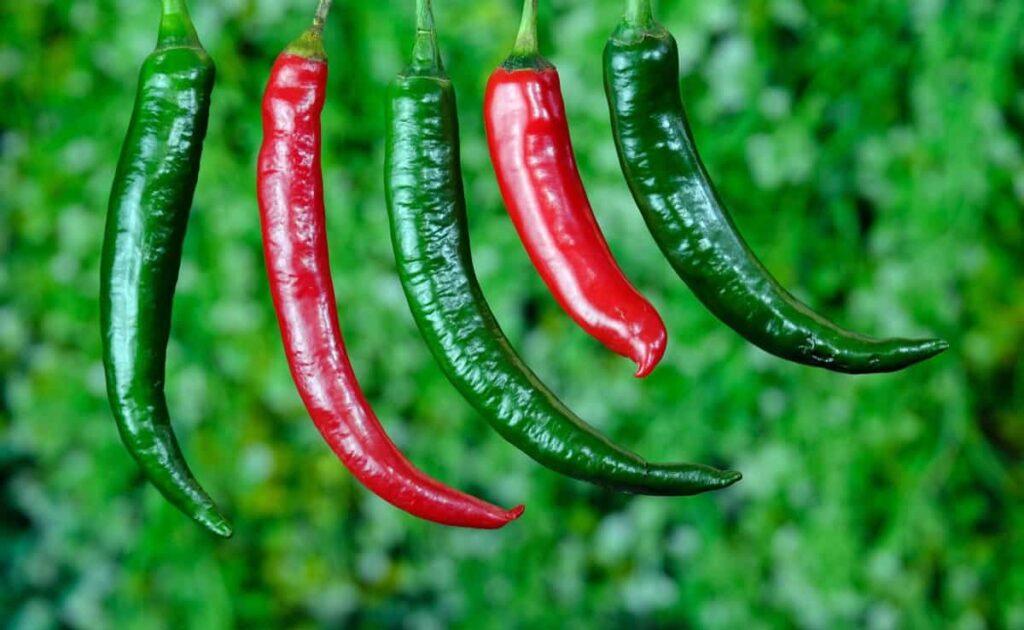Chilli is cultivated in a large part of the country. India not only has good consumption of chillies but also exports chillies to other countries. Indian Vegetable Research Institute, Varanasi, has developed some such varieties of chillies, which farmers can plant to get a good production.
In India, chillies are cultivated in an area of about 7.33 lakh hectares. The central chilli producing states include Andhra Pradesh, Telangana, Madhya Pradesh, Karnataka, Gujarat and West Bengal. India exported 44,415.73 metric tonnes of chillies worth Rs 25,976.32 lakh in 2019-20 to countries like UAE, UK, Qatar, Oman.
In the four-day Krishi Vigyan Congress organized at Banaras Hindu University (BHU) on November 13-16, an exhibition was also scheduled for the awareness of farming. Where many varieties of the exhibition were also put up, here, eight types of chilli caught most people’s attention.
Kashi Tej (CCH-4)
This variety is suitable for both dry and green production. This variety is early maturing, intense and resistant to diseases like anthracnose, fruit rot disease and thrips. This variety can be cultivated in Uttar Pradesh and yields 14.2 tonnes per hectare. For its nursery, 300-400 grams of seed is required per hectare. Fruits mature quickly, and the first harvesting can be done 35-40 days after planting. During the preparation of the field, 20-30 tons/ha of compost or cow dung should be used. N:P:K @ 120:80:80 kg/ha has been recommended for chilli cultivation. Apart from this, it needs good field preparation. So, you can prepare the soil with the help of rich quality tractors like Farmtrac 60 Powermaxx and others.
Kashi Ratna CCH-12 (F1) Hybrid
This variety gives a 20-22 tones/ha yield and is tolerant to anthracnose and thrips. It is cultivated for green chillies. The early maturing variety has been developed for cultivation in Uttar Pradesh. While transplanting this variety, apply NPK @ 150: 80: 80 kg per hectare. The seeds of the Kashi Ratna variety are sown from July to August, and the plants should be transplanted in August-September.
Kashi Aura (VR-339)
The fruits of this variety are very spicy with small sizes. Tolerant to biotic (anthracnose, CLCV, thrips and mites) and abiotic stresses (low and high temperatures). In this, the production is 15 tonnes per hectare.
This variety has been developed for cultivation in Uttar Pradesh.
Kashi Abha variety nursery should be sown from July to August, and seedlings should be transplanted after 30 days of sowing. Planting must be done at a distance of 45 cm from plant to plant and 60 cm from row to row.
Four hundred fifty grams of seeds are sufficient for planting one hectare of chilli. During the preparation of the field, 20-30 tons/ha of compost or cow dung should be used. N:P: K @ 120:80:80 kg per hectare should be used.
Kashi Sindoori
Plants of this variety are spreading, and it is resistant to anthracnose disease. The fruits ripen 95-100 days after sowing, and the fruits are 10-12 cm long and 1.1-1.3 cm thick.
Its average yield is 140 quintals per hectare. This variety has been developed for the states of Karnataka, Tamil Nadu and Kerala.
450 gm seeds are sufficient for planting chilli in one hectare. During the preparation of the field, 20-30 tons/ha of compost or cow dung should be used. N:P: K @ 120:80:80 kg per hectare has been recommended for chilli cultivation.
Kashi Gaurav
Plants of this variety are bushy, dark green leaves and 50% flowers in 35-40 days after transplanting, and fruits are dark green and deep red when ripe 95-100 days after sowing. Its fruits are 9-11 cm long and 1.1- 1.2 cm thick.
The average red ripe fruit yield is 150 QTL/ha. Tolerant to anthracnose, thrips and mites.
This variety has been developed for the states like West Bengal and Assam in the winter season.
Four hundred fifty grams of seed is sufficient for planting in one hectare.
During the preparation of the field, 20-30 tonnes per hectare of compost or cow dung should be used. N:P:K @ 120:80:80 kg/ha has been recommended for chilli cultivation. Some excellent quality tractors like John deere 45 hp and others are useful to prepare the field.
Kashi Rukh
Plants of this variety are 1 to 1.2 m tall, and stems are erect. The colour of the fruits is light green, and the shape is straight. Their length is 11-12 cm.
The cultivar of the Kashi rukh variety is suitable for the production of red and green fruits. First harvesting starts 55 days after transplanting.
The yield of green fruits is 240 quintals per hectare, while the product of red fruits is about 140 quintals per hectare. This variety is cultivated in states like Uttar Pradesh and Madhya Pradesh.
Kashi Anmol
Plants of this variety are about 60-70 cm tall in dwarf size. First harvesting starts 55 days after transplanting. Production yields 200 quintals per hectare. In 120 days, about 250 quintals per hectare are produced.
Hybrid-Kashi Early
Plants of this variety are 100 to 110 cm tall, and the stem is light green. Its fruits are 8-9 cm long and 1 to 1.2 cm thick. The dark green fruits turn bright red when ripe. Fruits can be harvested after 45 days of transplanting.
This variety can be cultivated in states like Madhya Pradesh and Uttar Pradesh.
We hope this blog will teach you well. For more updates, stay tuned with us.






